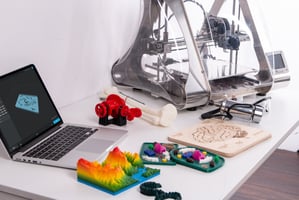At its most basic level, a belt is a looped strip of flexible material used to bind two or more...
Inspire Creativity With the Perfect Daily Routine
In order to solve problems effectively, engineers must learn to innovate. For them to design new products and services or improve on those that have already been created, a creative mindset is essential. This continuous innovation is essential for driving economic and societal growth.
How do you get yourself into a creative mindset? Do you swear by a round of push-ups each morning, or do you eat the same thing each day? Maybe your best work is done to the sound of the morning birds, or you can only get down to brass tacks once the sun has gone down.
Whatever your preferences, one thing is for sure: whether they are writers, artists, or mechanical engineers, creative people don't rely on sudden revelations. Instead, their insights come from a consistent pattern and routine to their days. It is the mastery of everyday habits (not some mysterious spark of inspiration) which leads to success.
Creativity and routine go hand in hand.
We all have little habits that inspire us to do our best work, and this was no different for history's greatest artists, singers, authors, and thinkers. The author Mason Currey investigates the lives and habits of 161 creative people in his novel, Everyday Rituals: How Artists Work.
Reflecting on each creative individual he profiles, he concludes that, more often than not, "grand creative visions translate to small daily increments." Creativity is forged on the back of working every day on the task at hand. Time and time again, Currey found that creative types throughout history owe their success to the monotony of their everyday routines.
Our everyday routines can either nurture our creative juices or hold them back. With a little practice, you can also structure a routine to maximize creative inspiration in your own life. Here are a few routines to consider.
Routine #1: Set regular working hours -- and stick to them.
The famous scientist Charles Darwin considered the hours of 8 -9.30 his best working hours, and he was usually done for the day by lunchtime. Working at the same time daily frees your mind from having to make the decision to work. Try to find your most productive time and stick to that schedule religiously. Some get more done at the crack of dawn; others swing into action in the afternoon. Observe the time of day your brain does its best work, and build your work schedule around these hours.
Routine #2: Take a daily walk.
Ludwig Van Beethoven often took the time to 'work while walking' and seek inspiration in the fresh air. Regardless of the weather, he never failed to venture out because they were essential for his imagination. Beethoven would always bring a pen and sheets of music paper on these walks in case he came across any new ideas. Walking is not just about putting one foot in front of the other - it's a way to clear away the cobwebs, solve problems, gather and flesh out new ideas.
Routine #3: Take a daily nap.
Albert Einstein was a huge fan of sleep, so much so that he relied on 10 hours at night, in addition to a series of daytime naps. He swore by micro-napping, which meant he never allowed himself to drift into stage two of sleep. To make sure of this, he would sit with a spoon in his favorite armchair and begin to doze off. A loud clatter would ensue when the spoon fell, which would wake him up.
As did the artist Salvador Dali, Einstein discovered that these hypnagogic naps boosted his creative intuition and opened his mind to new insights and problem-solving solutions.
Routine #4: Organize your workspace like a chef.
'Mise en place' is a French word which means 'putting in place' It is a philosophy for prepping kitchen equipment to produce dishes in the most efficient manner possible. It's also a word that often applies to the discipline and organization that a successful chef needs to convey to perform at their best in a busy commercial kitchen.
The idea is to maximize efficiency in the use of your body, your time, and your mental resources. This same idea can also be applied to your work environment.
Here are a few things to consider:
- Set up your work environment for success. Think about the items most essential to your work, and ensure they are close to hand at all times when working. This might be your trusty set of pliers, a pen, and paper, or even a full pot of coffee in the morning.
- Clean as you go. Put your tools away and clean your workspace regularly. It's crucial to do so at the end of the day so you can start fresh the next day.
- Eliminate distractions. From turning off your smartphone notifications to installing apps that block your favorite websites, remaining free from distractions ensures your mind is entirely focused on the task at hand.
Making minor tweaks to your daily routine can do wonders for inspiring innovation and fresh ideas when it comes to solving complex engineering problems. However, ensure you take the time to discover what works best for you. Just because one habit worked for someone you admire doesn't mean it will work for you. Experiment a little, and you'll eventually find a routine that inspires your best work.



